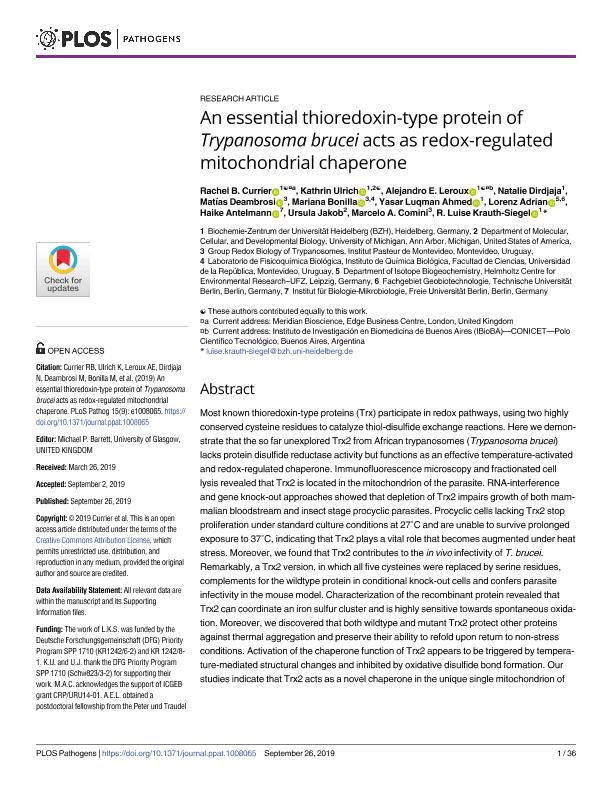Mostrar el registro sencillo del ítem
dc.contributor.author
Currier, Rachel B.
dc.contributor.author
Ulrich, Kathrin
dc.contributor.author
Leroux, Alejandro Ezequiel

dc.contributor.author
Dirdjaja, Natalie
dc.contributor.author
Deambrosi, Matías
dc.contributor.author
Bonilla, Mariana
dc.contributor.author
Ahmed, Yasar Luqman
dc.contributor.author
Adrian, Lorenz
dc.contributor.author
Antelmann, Haike
dc.contributor.author
Jakob, Ursula
dc.contributor.author
Comini, Marcelo A.
dc.contributor.author
Krauth-Siegel, R. Luise
dc.date.available
2021-02-03T11:57:00Z
dc.date.issued
2019-09
dc.identifier.citation
Currier, Rachel B.; Ulrich, Kathrin; Leroux, Alejandro Ezequiel; Dirdjaja, Natalie; Deambrosi, Matías; et al.; An essential thioredoxin-type protein of Trypanosoma brucei acts as redox-regulated mitochondrial chaperone; Public Library of Science; Plos Pathogens; 15; 9; 9-2019; 1-36
dc.identifier.issn
1553-7366
dc.identifier.uri
http://hdl.handle.net/11336/124565
dc.description.abstract
Most known thioredoxin-type proteins (Trx) participate in redox pathways, using two highly conserved cysteine residues to catalyze thiol-disulfide exchange reactions. Here we demonstrate that the so far unexplored Trx2 from African trypanosomes (Trypanosoma brucei) lacks protein disulfide reductase activity but functions as an effective temperature-activated and redox-regulated chaperone. Immunofluorescence microscopy and fractionated cell lysis revealed that Trx2 is located in the mitochondrion of the parasite. RNA-interference and gene knock-out approaches showed that depletion of Trx2 impairs growth of both mammalian bloodstream and insect stage procyclic parasites. Procyclic cells lacking Trx2 stop proliferation under standard culture conditions at 27°C and are unable to survive prolonged exposure to 37°C, indicating that Trx2 plays a vital role that becomes augmented under heat stress. Moreover, we found that Trx2 contributes to the in vivo infectivity of T. brucei. Remarkably, a Trx2 version, in which all five cysteines were replaced by serine residues, complements for the wildtype protein in conditional knock-out cells and confers parasite infectivity in the mouse model. Characterization of the recombinant protein revealed that Trx2 can coordinate an iron sulfur cluster and is highly sensitive towards spontaneous oxidation. Moreover, we discovered that both wildtype and mutant Trx2 protect other proteins against thermal aggregation and preserve their ability to refold upon return to non-stress conditions. Activation of the chaperone function of Trx2 appears to be triggered by temperature- mediated structural changes and inhibited by oxidative disulfide bond formation. Our studies indicate that Trx2 acts as a novel chaperone in the unique single mitochondrion of T. brucei and reveal a new perspective regarding the physiological function of thioredoxintype proteins in trypanosomes.
dc.format
application/pdf
dc.language.iso
eng
dc.publisher
Public Library of Science

dc.rights
info:eu-repo/semantics/openAccess
dc.rights.uri
https://creativecommons.org/licenses/by-nc-sa/2.5/ar/
dc.subject
Trypanosoma brucei
dc.subject
Thioredoxin
dc.subject
Redox
dc.subject
chaperone
dc.subject.classification
Bioquímica y Biología Molecular

dc.subject.classification
Ciencias Biológicas

dc.subject.classification
CIENCIAS NATURALES Y EXACTAS

dc.subject.classification
Parasitología

dc.subject.classification
Ciencias de la Salud

dc.subject.classification
CIENCIAS MÉDICAS Y DE LA SALUD

dc.title
An essential thioredoxin-type protein of Trypanosoma brucei acts as redox-regulated mitochondrial chaperone
dc.type
info:eu-repo/semantics/article
dc.type
info:ar-repo/semantics/artículo
dc.type
info:eu-repo/semantics/publishedVersion
dc.date.updated
2020-11-20T19:56:45Z
dc.journal.volume
15
dc.journal.number
9
dc.journal.pagination
1-36
dc.journal.pais
Estados Unidos

dc.journal.ciudad
San Francisco
dc.description.fil
Fil: Currier, Rachel B.. Universität Heidelberg; Alemania
dc.description.fil
Fil: Ulrich, Kathrin. Universität Heidelberg; Alemania. University of Michigan; Estados Unidos
dc.description.fil
Fil: Leroux, Alejandro Ezequiel. Consejo Nacional de Investigaciones Científicas y Técnicas. Oficina de Coordinación Administrativa Parque Centenario. Instituto de Investigación en Biomedicina de Buenos Aires - Instituto Partner de la Sociedad Max Planck; Argentina. Universität Heidelberg; Alemania
dc.description.fil
Fil: Dirdjaja, Natalie. Universität Heidelberg; Alemania
dc.description.fil
Fil: Deambrosi, Matías. Instituto Pasteur de Montevideo; Uruguay
dc.description.fil
Fil: Bonilla, Mariana. Instituto Pasteur de Montevideo; Uruguay
dc.description.fil
Fil: Ahmed, Yasar Luqman. Universität Heidelberg; Alemania
dc.description.fil
Fil: Adrian, Lorenz. Technishe Universitat Berlin; Alemania
dc.description.fil
Fil: Antelmann, Haike. Freie Universität Berlin; Alemania
dc.description.fil
Fil: Jakob, Ursula. University of Michigan; Estados Unidos
dc.description.fil
Fil: Comini, Marcelo A.. Instituto Pasteur de Montevideo; Uruguay
dc.description.fil
Fil: Krauth-Siegel, R. Luise. Universität Heidelberg; Alemania
dc.journal.title
Plos Pathogens

dc.relation.alternativeid
info:eu-repo/semantics/altIdentifier/url/http://dx.plos.org/10.1371/journal.ppat.1008065
dc.relation.alternativeid
info:eu-repo/semantics/altIdentifier/doi/http://dx.doi.org/10.1371/journal.ppat.1008065
Archivos asociados
